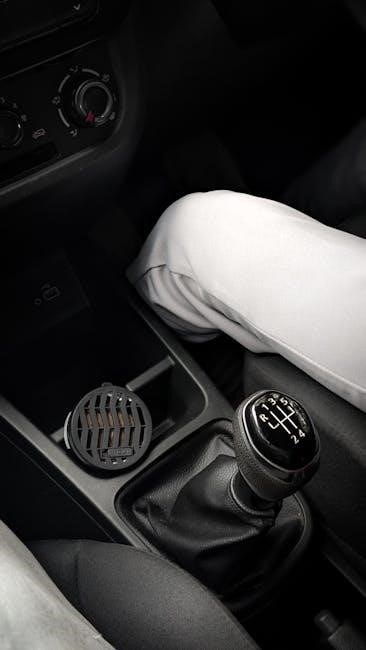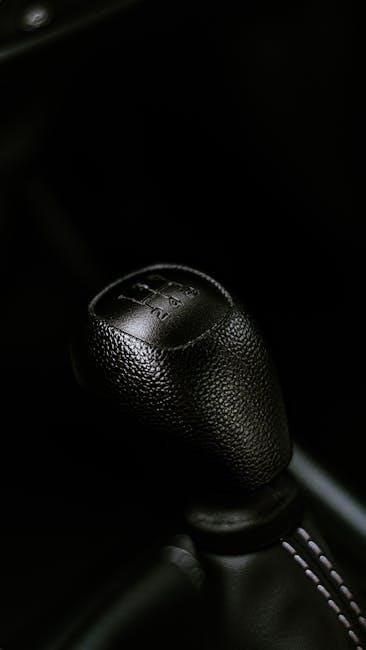Manual transmissions offer precise control and a connected driving experience‚ with synchronizers enabling smooth gear shifts by aligning shaft speeds seamlessly.
Overview of Manual Transmission Operation
A manual transmission operates by mechanically connecting and disconnecting gears to control vehicle speed. The driver engages gears using the clutch and shift lever‚ synchronizing shaft speeds to ensure smooth transitions. The transmission consists of an input shaft‚ output shaft‚ and countershaft‚ with gears meshing to provide various speed ratios. Synchronizers play a critical role by aligning gear and shaft speeds‚ enabling quick and seamless shifts without grinding. This system requires driver input and coordination to execute precise gear changes effectively.

What Are Synchronizers?
Synchronizers are critical components in manual transmissions‚ enabling smooth gear shifts by matching the speeds of rotating gears and shafts‚ eliminating the need for double-clutching.
Definition and Purpose of Synchronizers
Synchronizers are mechanical components in manual transmissions that enable smooth gear transitions by synchronizing the rotational speeds of the input and output shafts. Their primary purpose is to ensure that gears mesh seamlessly‚ preventing grinding and wear. By equalizing shaft speeds‚ synchronizers eliminate the need for double-clutching‚ allowing drivers to shift gears effortlessly and efficiently. This critical function enhances shifting quality‚ reduces driver effort‚ and prolongs transmission longevity‚ making them indispensable in modern manual transmissions.
Key Components of a Synchronizer Assembly
A synchronizer assembly typically consists of a hub‚ blocker ring‚ shift sleeve‚ and struts. The hub connects to the gear‚ while the blocker ring engages to synchronize speeds. The shift sleeve facilitates gear engagement‚ and struts provide mechanical support. These components work together to ensure smooth‚ precise gear transitions by aligning and synchronizing shaft speeds during shifting.
How Synchronizers Work
Synchronizers ensure smooth gear shifts by adjusting the speed of the input and output shafts‚ aligning them before engagement to prevent gear clash and facilitate seamless transitions.
The Synchronization Process Explained
The synchronization process involves the synchronizer adjusting the speed of the input shaft to match the output shaft‚ ensuring gears align smoothly. When shifting‚ the driver presses the clutch‚ disengaging the engine from the transmission. The synchronizer then engages‚ using friction to synchronize shaft speeds. Once aligned‚ the gear meshes without grinding‚ allowing the clutch to re-engage seamlessly. This process eliminates the need for double-clutching‚ making manual shifting efficient and fluid.
Engagement of Gears and Shaft Alignment
During gear engagement‚ the synchronizer ensures the input and output shafts align in speed and position. The slider‚ guided by the shift fork‚ moves to engage the desired gear. The synchronizer ring frictionally locks the gear to the shaft‚ preventing grinding. Once aligned‚ the dog teeth on the gear mesh with the slider‚ securing the gear in place. This precise alignment enables smooth power transfer‚ ensuring efficient and controlled gear changes without damage to the transmission components.

Types of Synchronizers
Manual transmissions utilize block-type‚ plain-type‚ and pin-type synchronizers‚ each designed to facilitate smooth gear engagement by aligning shaft speeds and minimizing wear on components.
Block-Type Synchronizers
Block-type synchronizers are a common design in manual transmissions‚ featuring a blocker ring with friction surfaces that engage gears. They facilitate smooth gear transitions by matching shaft speeds‚ reducing wear and tear. These synchronizers are known for their durability and effectiveness in high-performance applications‚ providing consistent and reliable shifting across various driving conditions.
Plain-Type Synchronizers
Plain-type synchronizers are the simplest design‚ utilizing a friction ring to synchronize gear speeds. They are lightweight and cost-effective‚ making them ideal for basic manual transmissions. These synchronizers rely on direct contact between the blocker ring and gear teeth to equalize speeds‚ ensuring smooth engagement without the complexity of additional components. They are widely used in entry-level vehicles and older transmission systems due to their simplicity and ease of maintenance.
Pin-Type Synchronizers
Pin-type synchronizers use a pin or strut mechanism to engage gears‚ offering a reliable and durable solution for manual transmissions; These synchronizers feature a blocker ring and friction surfaces that align gear speeds before engagement. The pin design helps reduce wear and tear by distributing forces evenly‚ making them suitable for high-performance applications. Their robust construction ensures smooth shifting‚ even under heavy loads‚ making them a preferred choice in demanding driving conditions and heavy-duty vehicles.
Common Problems with Synchronizers
Common problems with synchronizers include worn or damaged synchronizer rings‚ grinding gears‚ and premature wear due to high mileage or improper shifting techniques.
Worn or Damaged Synchronizer Rings
Worn or damaged synchronizer rings are a common issue‚ causing grinding gears and resistance during shifts. Over time‚ high mileage or improper shifting can wear down the rings‚ leading to poor engagement and requiring replacement to maintain smooth transmission operation.
Grinding Gears and Other Symptoms
Grinding gears are a common symptom of worn or damaged synchronizers‚ indicating misaligned shaft speeds during shifts. Other signs include resistance when engaging gears‚ unusual noises‚ and difficulty shifting. These issues often result from worn synchronizer rings or blocked components‚ which prevent proper gear alignment. Addressing these symptoms promptly is crucial to avoid further damage to the transmission and ensure smooth operation.

Advanced Synchronizer Designs
Advanced synchronizer designs‚ like the TREMEC multi-cone system‚ enhance friction surface area for smoother‚ faster shifts‚ optimizing performance in high-RPM applications and delivering superior driver control.
TREMEC Multi-Cone Synchronizers
TREMEC multi-cone synchronizers feature a advanced design with multiple friction cones‚ increasing the surface area for smoother‚ quicker shifts. This innovation enhances high-RPM performance‚ reducing wear and heat generation. Ideal for racing and high-performance applications‚ these synchronizers improve shift quality and durability‚ ensuring precise gear engagement and reduced clutch wear. Their robust construction makes them a preferred choice for demanding driving conditions‚ delivering unparalleled responsiveness and control behind the wheel.
Improved Friction Surface Area for Smoother Shifts
Advanced synchronizer designs‚ like multi-cone systems‚ significantly increase the friction surface area. This enhances the ability to match gear speeds quickly and smoothly‚ reducing wear and heat generation. The larger contact area allows for more efficient energy transfer‚ resulting in faster synchronization and seamless shifts; This innovation is particularly beneficial in high-performance applications‚ where rapid and precise gear changes are critical. Improved friction surface area directly translates to better shift quality and driver satisfaction.
Maintenance and Repair
Regular maintenance of synchronizers ensures smooth operation. This includes checking lubrication levels and replacing worn components promptly to prevent transmission damage. Addressing issues early avoids costly repairs.
Best Practices for Synchronizer Maintenance
Regular lubrication checks are essential for maintaining synchronizer health. Inspect synchronizer rings and bearings for wear or damage. Address issues promptly to prevent costly repairs. Use high-quality transmission fluid and ensure proper fluid levels. Avoid aggressive shifting‚ as it can stress synchronizers. Follow manufacturer-recommended service intervals for optimal performance. These practices help extend the lifespan of synchronizers and ensure smooth‚ reliable gear shifts.
When to Replace Synchronizers
Replace synchronizers if you notice grinding gears‚ difficulty shifting‚ or a “crunching” sound during gear changes. Worn or damaged synchronizer rings or bearings require immediate attention. If shifts become erratic or labored‚ it may indicate failing synchronizers. Inspect for excessive wear during transmission servicing. Early replacement prevents further damage to gears and shafts‚ ensuring smooth operation and maintaining transmission longevity. Always consult a professional for accurate diagnosis and repair.

The Evolution of Synchronizers
Synchronizers have evolved from basic designs to advanced multi-cone systems‚ eliminating double-clutching and enabling smoother‚ faster shifts in modern manual transmissions over the past decades.
Historical Development of Synchronizers
The concept of synchronizers emerged in the mid-20th century‚ revolutionizing manual transmissions by eliminating the need for double-clutching. Early designs were basic but effective‚ ensuring gears could mesh smoothly without grinding. Over time‚ advancements like multi-cone systems improved friction surface area‚ enabling faster and smoother shifts. These innovations marked a significant leap in transmission technology‚ enhancing driver convenience and performance. Today‚ modern synchronizers continue to evolve‚ offering unparalleled reliability and efficiency in gear changes.
Modern Innovations in Synchronizer Technology
Contemporary synchronizer designs feature advanced materials and multi-cone systems‚ significantly increasing friction surface area for quicker shifts. TREMEC’s Magnum 6-speed transmission exemplifies this‚ utilizing multi-cone synchronizers to enhance performance across a broader RPM range. These innovations ensure smoother transitions and improved durability‚ catering to high-performance applications. Modern synchronizers also integrate wear-resistant coatings and optimized tooth geometries‚ reducing wear and tear while maintaining precise control over gear engagement.
Synchronizers are essential for seamless gear shifts in modern manual transmissions‚ ensuring smooth performance and reducing gear wear. Their evolution has enhanced driving efficiency and satisfaction significantly.
Importance of Synchronizers in Modern Manual Transmissions
Synchronizers are crucial for modern manual transmissions‚ enabling smooth‚ efficient gear shifts without double-clutching. They ensure shaft speed alignment‚ reduce gear wear‚ and provide quicker transitions. By eliminating the need for complex shifting techniques‚ synchronizers make driving more accessible and enjoyable. Their role in preventing gear clash and maintaining transmission durability underscores their significance in contemporary automotive design‚ enhancing both performance and driver satisfaction.